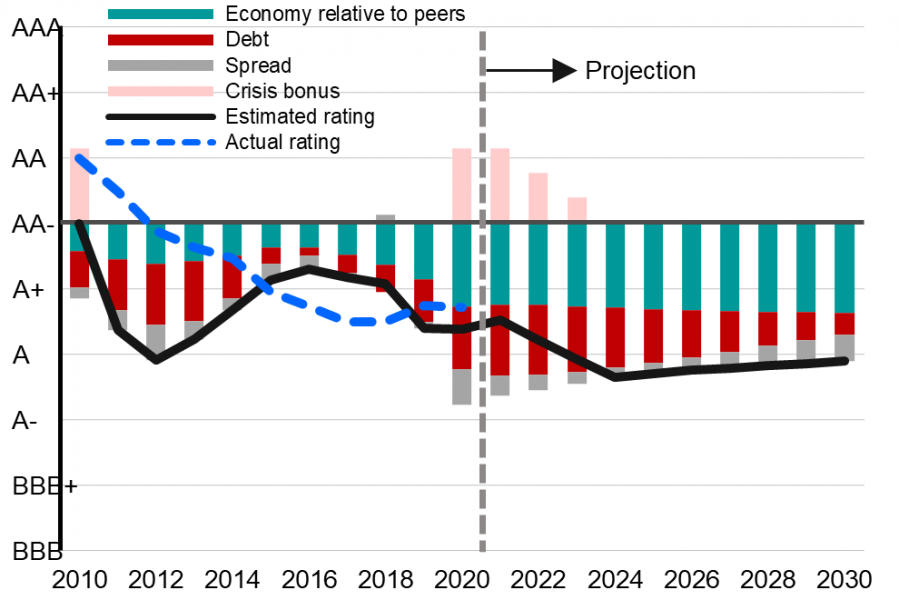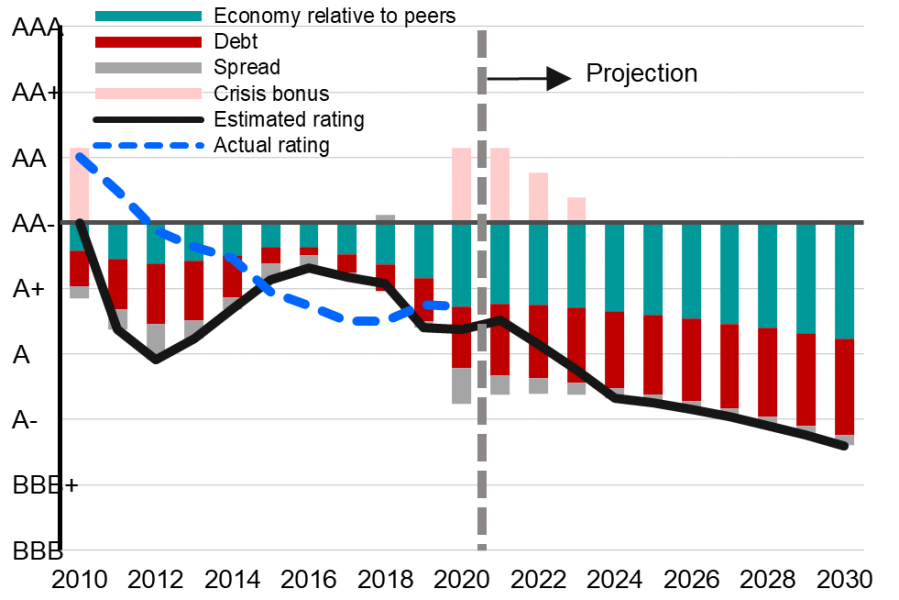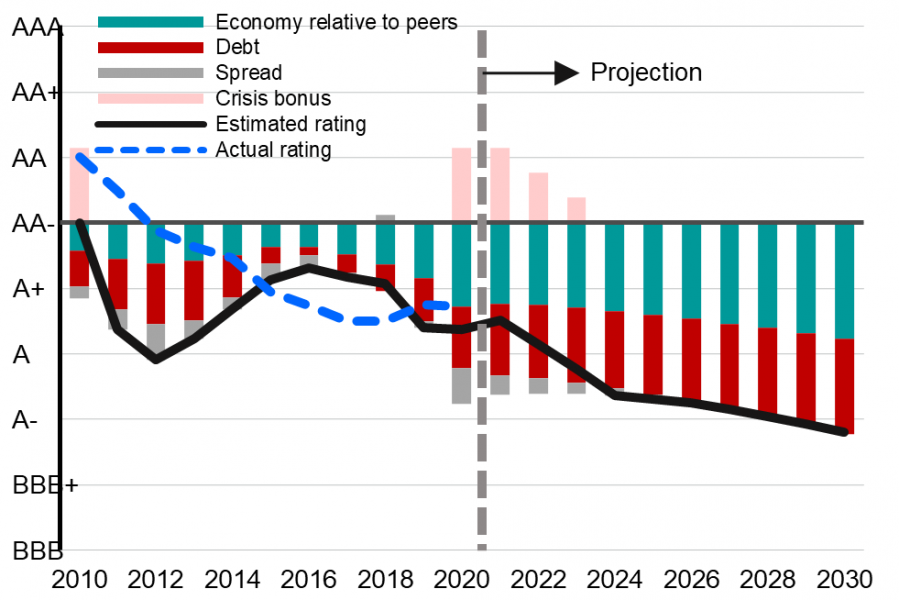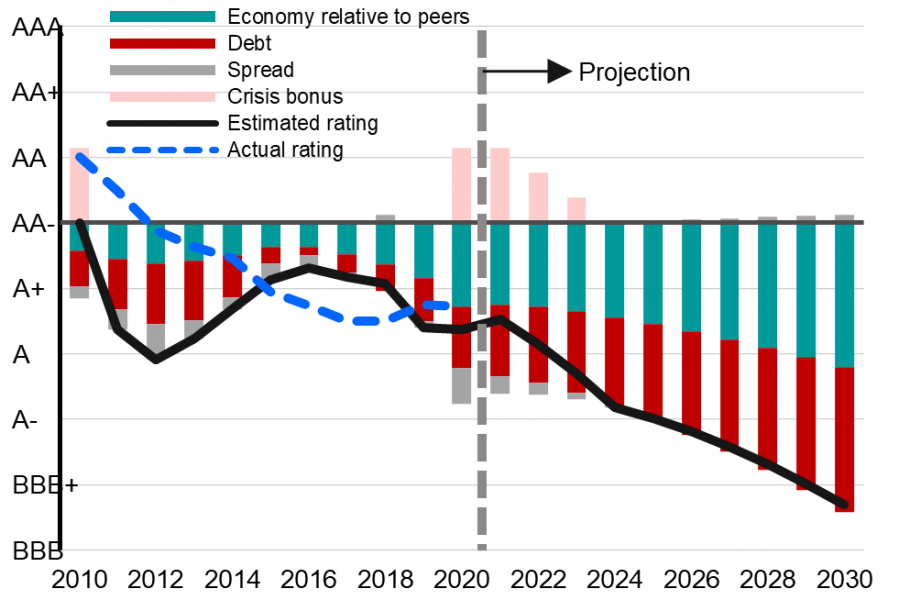References
Almeida, Heitor, Igor Cunha, Miguel A. Ferreira and Felipe Restrepo, 2016. “The Real Effects of Credit Ratings: The Sovereign Ceiling Channel.” Journal of Finance, 72(1), pp. 249-290.
Choi J., Den Ruijter A., Jiang K., and Moshammer E., “Japan’s sovereign rating in the post-pandemic era.” European Stability Mechanism, Working Paper Series Volume 2022, No. 52.
Fitch Ratings, 2021. “Fitch Affirms Japan at ’A’; Outlook Negative”, August 11, 2021.
Fitch Ratings, 2022. “Fitch Revises Outlook on Japan to Stable; Affirms at ’A’”, March 25, 2022.
International Monetary Fund, 2021. Balance of Payments and International Investment Position Statistics, updated 28 April 2021.
Moody’s, 2013. “Sovereign Bond Ratings Methodology”, September 2013.
Moody’s, 2022. “Government of Japan – A1 stable – Credit Opinion”, April 4, 2022.
S&P, 2020. “S&P revises Japan’s outlook to stable from positive over debt concerns”, June 9, 2020.
Sveriges Riksbank, 2020. “Regulations for the Gold and Foreign Exchange Reserves.” October 2020.
|
About the authors
Jinho Choi is responsible for undertaking the AMRO country surveillance work for Japan (Desk economist), as well as participating in the surveillance framework development on the fiscal side of the ASEAN+3 member countries. Prior to joining AMRO, Dr. Choi worked for the Bank of Korea from December 1999 to March 2016 as economist and senior economist in Research Department, Monetary Policy Department, and International Department. At the Bank of Korea, Dr. Choi conducted a wide range of policy-oriented research including the effectiveness of Korea’s fiscal stimulus, asymmetric behavior of Korean households’ inflation expectations, and dynamic effects on terms of trade shocks. His recent articles have been published in several international journals, such as Quantitative Economics, Journal of Applied Econometrics and Economic Modelling. He holds a Ph.D. in Economics from Indiana University at Bloomington, USA, and a Master in Applied Economics from the University of Michigan at Ann Arbor, USA. Dr. Choi graduated with M.B.A. in Finance and B.A. in Economics from Seoul National University.
Alexander den Ruijter is Senior Risk Officer at the European Stability Mechanism. In his daily work, he focuses on sovereign credit risk and coordinates the activities of the credit risk function. Prior to joining the ESM’s Risk Management department, he was Advisor to the Managing Director of the ESM for three years. In 2012-2013 he worked in the ESM’s Strategy and Institutional Relations division. Before joining the ESM, Alexander worked as a policy expert in the Ministry of Finance of the Netherlands, where he focused on the EU’s fiscal rules and advised on the development of the EFSF and the ESM. He holds a Master of Arts in Economics from Boston University, a B.Sc. in International Economics and Finance from Tilburg University, and a Certificate in Risk Management from the University of Zurich.
Kimi Xu Jiang is the desk economist for Korea, as well as an economist in the China and Hong Kong, China team. Previously, he was the desk economist for Hong Kong, China and provided support to the Japan team. He joined the Surveillance Group at the ASEAN+3 Macroeconomic Research Office (AMRO) in November 2020.Prior to joining AMRO, Kimi was a financial market expert at the European Stability Mechanism (ESM), mainly focusing on the monitoring and analysis of emerging risks to Euro Area sovereign debt markets. Kimi started his career as a policy advisor at the financial market division of the Dutch Central Bank (DNB), working in the areas of monetary operations and financial market intelligence. Kimi holds a Research Master and Bachelor in Economics from Tilburg University, the Netherlands, and is currently pursuing a part-time Ph.D. in Economics at Vrije Universiteit Amsterdam.
Edmund Moshammer is Senior Economist at the Economic and Market Analysis division of the European Stability Mechanism. He is responsible for the cross-country monitoring of economic and financial developments. Mr Moshammer has co-developed several modelling frameworks such as a dynamic factor model, a tool for debt sustainability analysis, a composite indicator of sovereign distress, a portfolio optimization toolkit, as well as a financial market database on auctions and high frequency trading data. Edmund also took a key role in the production of the ESM Programme Database. He previously worked at the European Central Bank (ECB) and he holds a Master’s degree from Barcelona Graduate School of Economics. Besides his research interests in time series econometric modelling, forecasting, and macroeconomics, Edmund has a publication track record in the fields of debt sustainability analysis, early warning indicators, and credit ratings.
|










